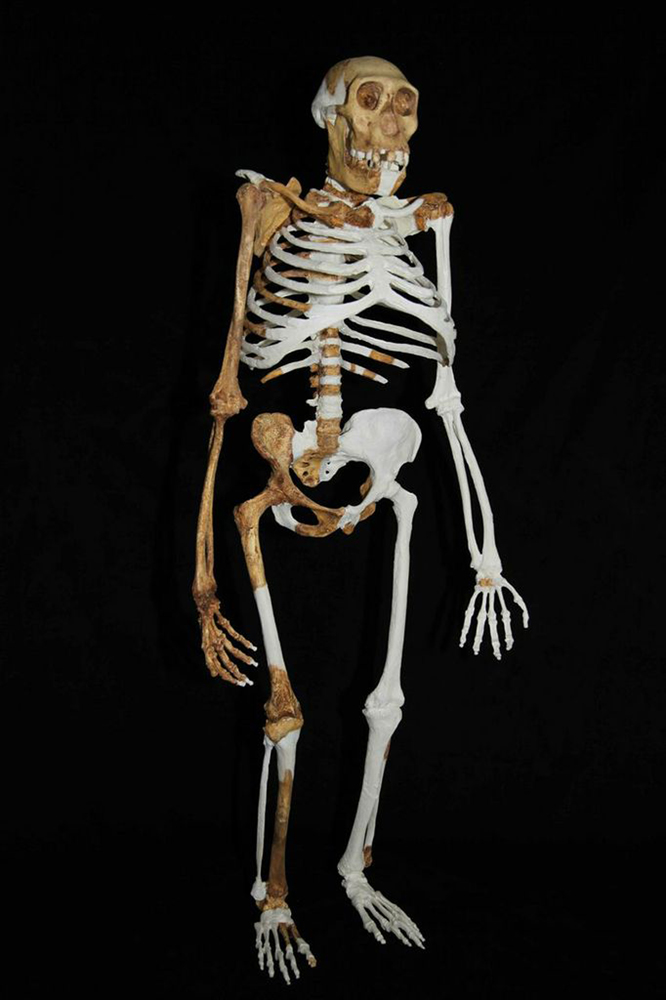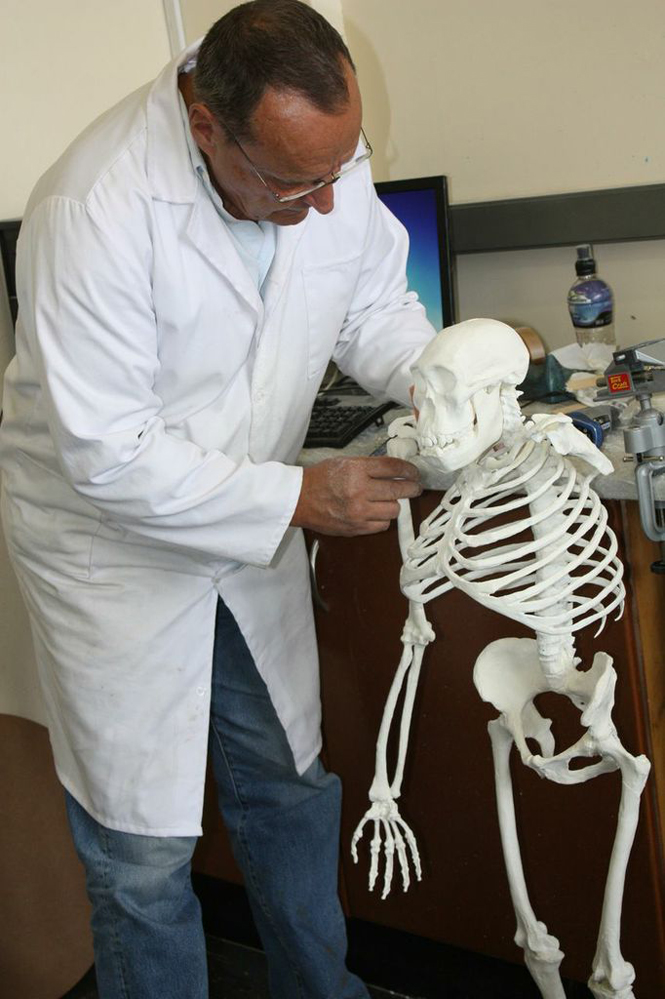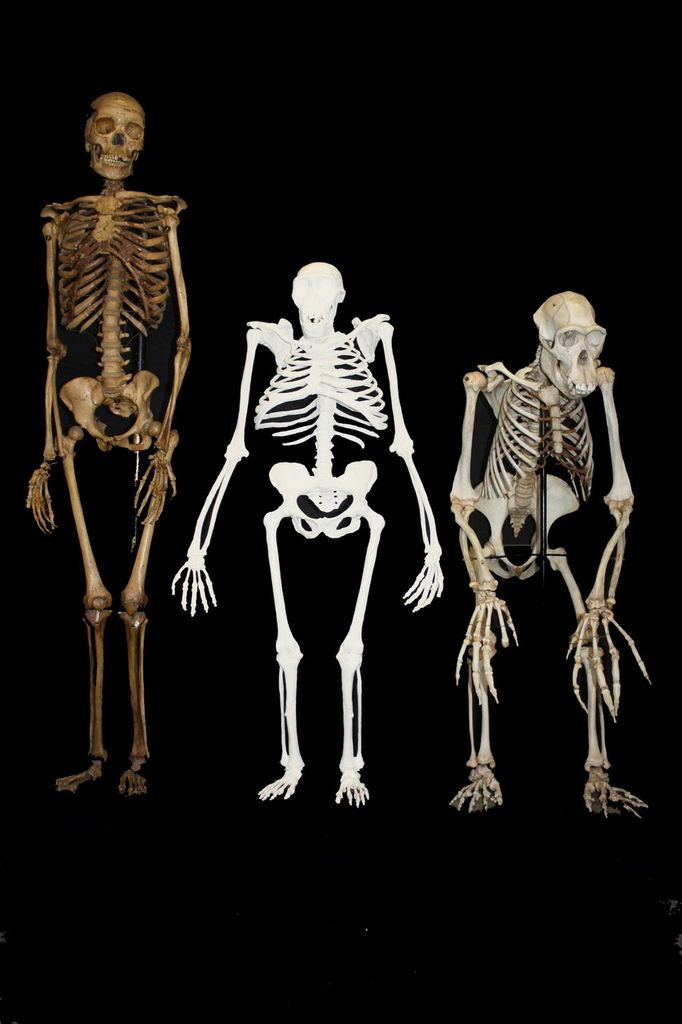A team of scientists has pieced together how the hominid Australopithecus sediba (Au. sediba) walked, chewed, and moved nearly two million years ago. Their research, which appears in six papers in the latest issue of the journal Science, also shows that Au. sediba had a notable feature that differed from that of modern humans—a functionally longer and more flexible lower back.
Together, the studies offer a comprehensive depiction of some of the most complete early human ancestral remains ever discovered.
Since its discovery in August 2008, the site of Malapa—located about 30 miles northwest of Johannesburg—has yielded more than 220 bones of early hominins representing more than five individuals, including the remains of babies, juveniles, and adults. The evidence published in Science is based on two individuals from the site. The fossils from the site date to 1.977 to 1.98 million years in age.

“The abundance and remarkable preservation of fossils from Malapa provide unique insights into the way this fascinating extinct species interacted with and moved around in its environment,” said New York University anthropologist Scott Williams, the lead author of one of the six papers appearing in Science
Williams, part of NYU’s Center for the Study of Human Origins, and his colleagues authored a paper describing Au. sediba’s vertebral column. The work is the first to analyze elements of the cervical, thoracic, lumbar, and sacral regions of the vertebral column in Au. sediba. Their analysis was based on partially complete spines of the two Au. sediba
Their study reveals that Au. sediba had a human-like curvature of the lower back, but it was functionally longer and more flexible than that of modern humans.

“They probably walked in a way that we might find strange—a ‘compromise’ form of bipedalism indicative of a hominin that still partially relied on climbing trees,” Williams explained.
He noted that “the adult female is the first early hominin skeleton that preserves an intact terminal thoracic region and this provides critical information on the transition in inter-vertebral joints, and, by inference, mobility of the lower back.”
“The bony spine of Au. sediba likely had the same number of vertebrae as that of modern humans,” Williams added. “However, it differed in one primary aspect of its configuration—the transition in inter-vertebral articular facets occurred at a higher level of the spine that than normally occurs in modern humans. In combination with other features, a functionally longer lower back would have allowed for a more flexible spine in Au. sediba relative to that of modern humans.”
In addition, morphological indicators of strong lumbar curvature suggest that Au. sediba evolved in this regard relative to Au. africanus, which lived between 3.03 and 2.04 million years ago, and closer to the more recent Nariokotome Homo erectus skeleton—to date, the most complete early human skeleton discovered.
The research was conducted at the Evolutionary Studies Institute (ESI) at the University of the Witwatersrand (Wits) in South Africa, where Au. sebida’s remains were discovered in 2008.
Overall, the fossils provide an “unprecedented insight into the anatomy and phylogenetic position of an early human ancestor,” observed Professor Lee Berger, the project leader from the Wits Evolutionary Studies Institute. “This examination of a large number of associated, often complete and undistorted elements, gives us a glimpse of a hominin species that appears to be mosaic in its anatomy and that presents a suite of functional complexes that are both different from that predicted for other australopiths, as well as that for early Homo
“Such clear insight into the anatomy of an early hominin species will clearly have implications for interpreting the evolutionary processes that affected the mode and tempo of hominin evolution and the interpretation of the anatomy of less well preserved species.”
AU. SEDIBA FACT SHEET ON SIX PAPERS
INTRODUCTION: MOSAIC ANATOMY OF AUSTRALOPETHICUS SEDIBA
Prof. Lee Berger, researcher in the Wits Evolutionary Studies Institute (ESI) at the University of the Witwatersrand, project leader and lead author of the introduction entitled Mosaic Anatomy of Australopethicus Sediba, summarises that Au. sediba provides the most comprehensive examination of the anatomy of a definitive single species of early hominin.
“This examination of a large number of associated, often complete and undistorted elements, gives us a glimpse of a hominin species that appears to be mosaic in its anatomy and that presents a suite of functional complexes that are both different from that predicted for other australopiths, as well as that for early Homo,” says Berger.
“Such clear insight into the anatomy of an early hominin species will clearly have implications for interpreting the evolutionary processes that affected the mode and tempo of hominin evolution and the interpretation of the anatomy of less well preserved species.”
DENTAL MORPHOLOHY AND THE PHYLOGENETIC “PLACE” OF AUSTRALOPETHICUS SEDIBA
The first paper, by lead author Prof. Joel Irish from the Research Centre for Evolutionary Anthropology and Palaeoecology at Liverpool John Moores University in the United Kingdom and his co-authors, examines non-metric dental traits in Au. sediba.
The study concludes that the species is distinct from east African australopiths, but is close to Au. africanus, thus forming a southern African australopith clade.
The latter, in turn, shares a number of derived states with a clade comprising four fossil samples of the genus Homo. This surprising result has significant implications for our present understanding of hominin phylogeny through the terminal Pliocene, and alludes to the possibility that Au. sediba, and perhaps Au. africanus are not descendant from the Au. afarensis lineage.
Irish noted that even though the results of this study were surprising and were bound to be viewed as controversial given the long held hypotheses relating to the origins of the genus Homo he would have come to the same conclusion.
“The extreme age and rarity of these fossils naturally draws enhanced interest in and scrutiny of any new findings. Based on the evidence, I would have come up with the same conclusions whether the samples were three million or 30 years old. If I had found that Au. sediba was totally distinct from all other hominins, I would have been just has happy to report that,” says Irish.
MANIDBULAR REMAINS SUPPORT TAXONOMIC VALIDITY OF AUSTRALOPETHICUS SEDIBA
Prof. Darryl de Ruiter from the Department of Anthropology, Texas A&M and the Evolutionary Studies Institute at the University of the Witwatersrand, and his co-authors examine new mandibular material attributable to MH2, including the previously unknown mandibular incisors and premolars of Au. sediba held in a spectacular new mandibular specimen associated with the female paratype specimen.
The study concludes, as is seen elsewhere in the cranium and skeleton, these mandibular remains share similarities with other australopiths, but can be differentiated from the southern African ape-man Au. africanus in both size and shape, as well as in their unique ontogenetic growth trajectory.
“These results add further support to the claim that Au. sediba is taxonomically distinct from the temporally – and geographically – close species Au. africanus. Where the Au. sediba mandibles differ from those of Au. africanus, they appear most similar to representatives of early Homo,” says De Ruiter.
He adds that “everywhere we look in these skeletons, from the jaws on down to the feet, we see evidence of the transition from australopith to Homo; everywhere we see evidence of evolution.”
THE UPPER LIMB OF AUSTRALOPETHICUS SEDIBA
In the third paper by Prof. Steven Churchill from the Department of Evolutionary Anthropology at Duke University and the Evolutionary Studies Institute at University of the Witwatersrand, he and his co-authors describe new, remarkably well preserved upper limb elements of Au. sediba.
The paper announces the first complete (or nearly complete) and undistorted humerus, radius, ulna, scapula, clavicle and manubrium (a frontal chest bone) yet described from the early hominin record, all associated with one individual.
The authors note that with the exception of the hand skeleton (which exhibits a suite of derived features that may signal enhanced manipulative capabilities relative to earlier australopiths), the upper limbs of the Malapa hominins are largely primitive in their morphology. Au. sediba thus shares with other australopiths an upper limb that was well-suited for arboreal or other forms of climbing and possibly suspension, though perhaps more so than has been previously suggested for any other member of this genus.
Churchill adds that “it is possible that the climbing features in the skeleton of Australopithecus sediba and other australopiths are functionally unimportant primitive traits retained from a more arboreal ancestor. Even so, it is curious that these features persist unchanged for several million years, only to abruptly disappear with the emergence of the genus Homo.”
MOSAIC MORPHOLOGY IN THE THORAX OF AUSTRALOPETHICUS SEDIBA
Remains of the rib cage of Au. sediba are described in the fourth paper by Dr Peter Schmid and his co-authors at the Evolutionary Studies Institute at the University of the Witwatersrand and the University of Zurich.
Their findings reveal a mediolaterally-narrow upper thorax like that of the large-bodied apes, and unlike the broad, cylindrical chest seen in humans. In conjunction with the largely complete remains of the shoulder girdle, Schmid notes that “the morphological picture that emerges is one of a conical thorax with a high shoulder joint that produces in Au. sediba an ape-like “shrugged” shoulder appearance, and thus a configuration that is perhaps uniquely australopith, and that would not have been conducive to human-like swinging of the arms during bipedal striding and running”.
The research however shows that the less well-preserved elements of the lower rib cage suggest a degree of human-like, mediolateral narrowing to the lower thorax. This indicates a surprising and rather unsuspected mosaic anatomy in the chest that is not like that observed in H. erectus or H. sapiens.
THE VERTEBRAL COLUMN OF AUSTRALOPETHICUS SEDIBA
Dr Scott Williams from the Center for the Study of Human Origins, Department of Anthropology, New York University and co-authors on the fifth paper describing the vertebral column of Au. sediba is the first paper to analyse elements of the cervical, thoracic, lumbar, and sacral regions of the vertebral column in Au. sediba.
Among the material described is a remarkably articulated lumbar vertebral region that shows a human-like curvature of the lower back. Williams notes that “the adult female is the first early hominin skeleton that preserves an intact terminal thoracic region and this provides critical information on the transition in inter-vertebral joints, and, by inference, mobility of the lower back”.
The study also demonstrates that Au. sediba had the same number of lumbar vertebrae as modern humans, but possessed a functionally longer and more flexible lower back. In addition, morphological indicators of strong lumbar curvature suggest that Au. sediba was derived in this regard relative to Au. africanus and more similar to the Nariokotome Homo erectus skeleton.
THE LOWER LIMB AND THE MECHANICS OF WALKING IN AUSTRALOPETHICUS SEDIBA
The sixth paper by Dr Jeremy DeSilva and his co-authors at Boston University and the Evolutionary Studies Institute at the University of the Witwatersrand describes the lower limb anatomy of Au. sediba is described and a specific biomechanical hypothesis is proposed as to how this species walked.
“The female Australopithecus sediba preserves a heel, ankle, knee, hip and lower back- all of the ingredients necessary to reconstruct how she walked with remarkable precision. Even the famous Lucy skeleton only preserves two of these five (ankle and hip)”, says DeSilva.
In isolation, the anatomies of the heel, mid-foot, knee, hip, and back are unique and curious, but in combination, they are internally consistent for a biped walking with a hyper-pronating gait.
“The implications of this study are that multiple forms of bi-pedalism were once practiced by our early hominin ancestors,” adds Berger.
Source: New York University
